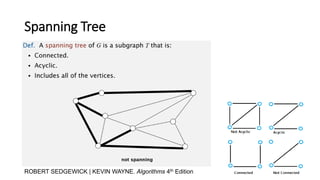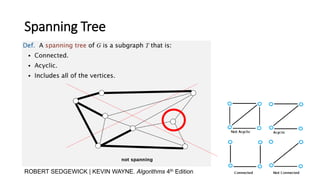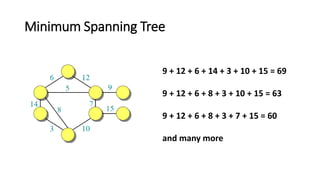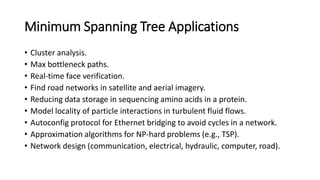Minimum Spanning Tree (MST), Kruskal's algorithm and Prim's Algorithm, and their Java codes
- 1. Minimum Spanning Tree (MST) - Kruskal’s algorithm and Prim’s algorithm, and their Java codes by Dr.Animesh Chaturvedi Assistant Professor: LNMIIT Jaipur Post Doctorate: King’s College London &TheAlanTuring Institute PhD: IIT Indore
- 2. Graph and Spanning Tree
- 4. Adjacency Matrix Representation of Graph
- 5. Adjacency List Representation of Graph
- 6. Spanning Tree • A tree T is said to be a spanning tree of a connected graph G, if T is a subgraph of G and T contains all vertices of G. • A graph G is said to be connected if there is at least one path between every pair of vertices in G. Otherwise, G is disconnected. • A disconnected graph with k components has a spanning forest consist of k spanning trees. • All spanning trees have exactly |V| - 1 edges.
- 7. Spanning Tree ROBERT SEDGEWICK | KEVIN WAYNE. Algorithms 4th Edition
- 8. Spanning Tree ROBERT SEDGEWICK | KEVIN WAYNE. Algorithms 4th Edition
- 9. Spanning Tree Properties • Every connected graph has at least one spanning tree. • An edge in a spanning tree T is called a branch of T. • A pendant edge in a graph G is contained in every spanning tree of G.
- 10. Spanning tree and Cut set • In a connected graph G, a cut-set is a set of edges whose removal from G leaves G disconnected, provided removal of no proper subset of these edges disconnects G. • Same is a true for a Spanning Tree as it is also a connected graph
- 11. Spanning tree and Cut set • Every cut-set in a connected graph G must contain atleast one branch of every spanning tree of G, the converse is also true. • In a connected graph G, any minimal set of edges containing at least one branch of every spanning tree of G is a cut-set.
- 13. Design of Electronic circuitry • In the Design of Electronic circuitry, pins of several components electrically equivalent by wiring them together. • To interconnect a set of n pins, • we can use an arrangement of n - 1 wires, • each connecting two pins • The one that uses the least amount of wire is usually the most desirable. Cormen, T. H., Leiserson, C. E., Rivest, R. L., & Stein, C. (2009). Introduction to Algorithms (Vol. 3, pp. 624-642). Cambridge: MIT press.
- 14. Design of Electronic circuitry Model this wiring problem with a connected, undirected graph G = (V, E), where V is the set of pins, E is the set of possible interconnections between pairs of pins. Find an acyclic subset that connects all the vertices and whose total weight is minimized the cost (amount of wire needed). This forms a tree T as a acyclic and connects all of the vertices, which we call the minimum-spanning-tree Cormen, T. H., Leiserson, C. E., Rivest, R. L., & Stein, C. (2009). Introduction to Algorithms (Vol. 3, pp. 624-642). Cambridge: MIT press.
- 15. Minimum Spanning Tree • “minimum spanning tree” is a shortened form of the phrase “minimum-weight spanning tree.” • Minimizing the number of edges in T, • Graph is connected and Edge weights are distinct. Then, MST exists and is unique. • All spanning trees have exactly |V| - 1 edges Cormen, T. H., Leiserson, C. E., Rivest, R. L., & Stein, C. (2009). Introduction to Algorithms (Vol. 3, pp. 624-642). Cambridge: MIT press. ROBERT SEDGEWICK | KEVIN WAYNE. Algorithms 4th Edition
- 16. Minimum Spanning Tree • The weights on edges and the edges in a minimum spanning tree are shaded. The total weight of the tree is 37. • This minimum spanning tree is not unique: removing the edge (b, c) and replacing it with the edge (a, h ) yields another spanning tree with weight 37. Cormen, T. H., Leiserson, C. E., Rivest, R. L., & Stein, C. (2009). Introduction to Algorithms (Vol. 3, pp. 624-642). Cambridge: MIT press.
- 17. Minimum Spanning Tree and Cut-sets • A cut in a graph is a partition of its vertices into two (nonempty) sets. • A crossing edge connects a vertex in one set with a vertex in the other. • Cut property. Given any cut, the crossing edge of min weight is in the MST. ROBERT SEDGEWICK | KEVIN WAYNE. Algorithms 4th Edition
- 18. Minimum Spanning Tree and Cut-sets • Suppose min-weight crossing edge e is not in the MST. • Adding e to the MST creates a cycle. • Some other edge f in cycle must be a crossing edge. • Removing f and adding e is also a spanning tree. • Since weight of e is less than the weight of f, that spanning tree is lower weight. • Contradiction ROBERT SEDGEWICK | KEVIN WAYNE. Algorithms 4th Edition
- 19. GENERIC-MST • Safe edge for A, since it can be safely added to A while maintaining the invariant (MST do not form loop or cycle). • Initialization: line 1 the set A trivially satisfies the invariant. • Maintenance: The loop in lines 2-4 maintains the invariant by adding only safe edges • Termination: All edges (|V|-1) added to A are in a MST, and so the set A is returned in line 5 must be a minimum spanning tree. Cormen, T. H., Leiserson, C. E., Rivest, R. L., & Stein, C. (2009). Introduction to Algorithms (Vol. 3, pp. 624-642). Cambridge: MIT press.
- 20. Minimum Spanning Tree 9 + 12 + 6 + 14 + 3 + 10 + 15 = 69 9 + 12 + 6 + 8 + 3 + 10 + 15 = 63 9 + 12 + 6 + 8 + 3 + 7 + 15 = 60 and many more
- 21. Minimum Spanning Tree 9 + 5 + 6 + 8 + 3 + 7 + 15 = 53
- 22. Minimum Spanning Tree 24 + 4 + 6 + 8 + 10 + 11 + 7 = 70 9 + 4 + 6 + 8 + 10 + 11 + 7 = 55 and many more ROBERT SEDGEWICK | KEVIN WAYNE. Algorithms 4th Edition
- 23. Minimum Spanning Tree ROBERT SEDGEWICK | KEVIN WAYNE. Algorithms 4th Edition
- 24. Minimum Spanning Tree Applications • Cluster analysis. • Max bottleneck paths. • Real-time face verification. • Find road networks in satellite and aerial imagery. • Reducing data storage in sequencing amino acids in a protein. • Model locality of particle interactions in turbulent fluid flows. • Autoconfig protocol for Ethernet bridging to avoid cycles in a network. • Approximation algorithms for NP-hard problems (e.g., TSP). • Network design (communication, electrical, hydraulic, computer, road).
- 25. Kruskal’s algorithm and Prim’s algorithm
- 26. Kruskal’s algorithm and Prim’s algorithm • Two algorithms for solving the minimum spanning-tree problem: • Kruskal’s algorithm • Prim’s algorithm • The two algorithms are • greedy algorithms Cormen, T. H., Leiserson, C. E., Rivest, R. L., & Stein, C. (2009). Introduction to Algorithms (Vol. 3, pp. 624-642). Cambridge: MIT press. ROBERT SEDGEWICK | KEVIN WAYNE. Algorithms 4th Edition
- 27. Kruskal’s algorithm and Prim’s algorithm • At each step of an algorithm, one of several possible choices. Then, • Greedy strategy: make the choice that is the best at the moment • Not generally guaranteed to find globally optimal solutions to problems. • Certain greedy do yield a spanning tree with minimum weight. Cormen, T. H., Leiserson, C. E., Rivest, R. L., & Stein, C. (2009). Introduction to Algorithms (Vol. 3, pp. 624-642). Cambridge: MIT press.
- 28. Kruskal’s algorithm and Prim’s algorithm • An edge is a light edge crossing a cut if its weight is the minimum of any edge crossing the cut. • Light edge = minimum-weight crossing edge • Light edge satisfy MST properties, and its weight is the minimum of any other edges satisfying the MST properties. • more than one light edge crossing a cut in the case of ties. Cormen, T. H., Leiserson, C. E., Rivest, R. L., & Stein, C. (2009). Introduction to Algorithms (Vol. 3, pp. 624-642). Cambridge: MIT press.
- 29. Kruskal’s algorithm • Both Kruskal’s algorithm and Prim’s algorithm elaborate the generic algorithm because they uses a specific rule to determine a safe edge in line 3 of GENERIC-MST. • In Kruskal’s algorithm, • the set A is a forest. • the safe edge added to A is always a least-weight edge in the graph that connects two distinct components. • Greedy algorithm because it adds an edge of least possible weight to the forest. Cormen, T. H., Leiserson, C. E., Rivest, R. L., & Stein, C. (2009). Introduction to Algorithms (Vol. 3, pp. 624-642). Cambridge: MIT press.
- 30. • In Kruskal’s algorithm, • the set A is a forest. • the safe edge added to A is always a least-weight edge in the graph that connects two distinct components. • A tree is a connected, acyclic, undirected graph. • A forest is a set of trees (non necessarily connected) Kruskal’s algorithm
- 31. Kruskal’s algorithm • Shaded edges belong to the forest A being grown. • The edges are considered by the algorithm in sorted order by weight. • An arrow points to the edge under consideration at each step of the algorithm. • If the edge joins two distinct trees in the forest, it is added to the forest, thereby merging the two trees. Cormen, T. H., Leiserson, C. E., Rivest, R. L., & Stein, C. (2009). Introduction to Algorithms (Vol. 3, pp. 624-642). Cambridge: MIT press.
- 32. Kruskal’s algorithm • Shaded edges belong to the forest A being grown. • The edges are considered by the algorithm in sorted order by weight. • An arrow points to the edge under consideration at each step of the algorithm. • If the edge joins two distinct trees in the forest, it is added to the forest, thereby merging the two trees. Cormen, T. H., Leiserson, C. E., Rivest, R. L., & Stein, C. (2009). Introduction to Algorithms (Vol. 3, pp. 624-642). Cambridge: MIT press.
- 33. Kruskal’s algorithm • It uses a disjoint-set data structure to maintain several disjoint sets of elements. • A disjoint-set data structure keeps track of a set of elements partitioned into a number of disjoint (non-overlapping) subsets. • A union-find data structure performs three useful operations • Making a new set containing a new element. • Find: Determine which subset a particular element. This can be used for determining whether two elements are in the same subset. • Union: Join two subsets into a single set. https://en.wikipedia.org/wiki/Disjoint-set_data_structure Cormen, T. H., Leiserson, C. E., Rivest, R. L., & Stein, C. (2009). Introduction to Algorithms (Vol. 3, pp. 624-642). Cambridge: MIT press.
- 34. Kruskal’s algorithm • Each set contains the vertices in a tree of the current forest. The operation FIND-SET(u) returns a representative element from the set that contains u. • Thus, we can determine whether two vertices u and v belong to the same tree by testing whether FIND-SET(u) equals FIND-SET(v). • The combining of trees is accomplished by the UNION procedure. Cormen, T. H., Leiserson, C. E., Rivest, R. L., & Stein, C. (2009). Introduction to Algorithms (Vol. 3, pp. 624-642). Cambridge: MIT press.
- 35. Kruskal’s algorithm • Lines 1-3: initialize the set A to the empty set and create trees, one containing each vertex. • Line 4: The edges in E are sorted into non-decreasing order by weight. Cormen, T. H., Leiserson, C. E., Rivest, R. L., & Stein, C. (2009). Introduction to Algorithms (Vol. 3, pp. 624-642). Cambridge: MIT press.
- 36. Kruskal’s algorithm • The for loop in lines 5-8 checks, for each edge (u, v), whether the endpoints u and v belong to the same tree. • If they do, then the edge (u, v) cannot be added to the forest because it create a cycle, thus the edge is discarded. • Otherwise, the two vertices belong to different trees. • In this case, the edge (u, v ) is added to A in line 7, and the vertices in the two trees are merged in line 8. Cormen, T. H., Leiserson, C. E., Rivest, R. L., & Stein, C. (2009). Introduction to Algorithms (Vol. 3, pp. 624-642). Cambridge: MIT press.
- 37. Kruskal’s algorithm • Running time depends on the implementation of the disjoint set data structure • the set A in line 1 takes O(1) time, • MAKE-SET operations in the for loop of lines 2–3 takes O(V), • the time to sort the edges in line 4 is O(E lg E), • the for loop of lines 5–8 performs O(E) FIND-SET and UNION operations on the disjoint-set forest. • Observing that |E| < |V|2, we have lg|E| = O(lg V), and so we can restate the running time of Kruskal’s algorithm as O(E lg V). Cormen, T. H., Leiserson, C. E., Rivest, R. L., & Stein, C. (2009). Introduction to Algorithms (Vol. 3, pp. 624-642). Cambridge: MIT press.
- 38. Prim’s algorithm • Both Kruskal’s algorithm and Prim’s algorithm elaborate the generic algorithm because they uses a specific rule to determine a safe edge in line 3 of GENERIC-MST. • In Prim’s algorithm, • the set A forms a single tree. • the safe edge added to A is always a least-weight edge connecting the tree to a vertex not in the tree. • Greedy algorithm because the tree is augmented at each step with an edge that contributes the minimum amount possible to the tree’s weight. Cormen, T. H., Leiserson, C. E., Rivest, R. L., & Stein, C. (2009). Introduction to Algorithms (Vol. 3, pp. 624-642). Cambridge: MIT press.
- 39. Prim’s Algorithm • Prim’s algorithm operates much like Dijkstra’s algorithm for finding shortest paths in a graph. • The edges in the set A always form a single tree. • The tree starts from an arbitrary vertex and grows until the tree spans all the vertices in V. • At each step, a light edge is added to the tree A, that connects A to an isolated vertex. Cormen, T. H., Leiserson, C. E., Rivest, R. L., & Stein, C. (2009). Introduction to Algorithms (Vol. 3, pp. 624-642). Cambridge: MIT press.
- 40. Prim’s Algorithm • The root vertex is a. Shaded edges are in the tree being grown, and the vertices in the tree are shown in black. • The vertices in the tree determine a cut of the graph, and a light edge crossing the cut is added to the tree. • the algorithm has a choice of adding either edge (b, c) or edge (a, h) to the tree since both are light edges crossing the cut. Cormen, T. H., Leiserson, C. E., Rivest, R. L., & Stein, C. (2009). Introduction to Algorithms (Vol. 3, pp. 624-642). Cambridge: MIT press.
- 41. Prim’s Algorithm Lines 1-5 set the key of each vertex to ∞ (except for the root r, whose key is set to 0 so that it will be the first vertex processed). Set the parent of each vertex to NIL, and initialize the min-priority queue Q to contain all the vertices. • v.key is the minimum weight of any edge connecting v to a vertex in the tree • v.∏ is the names the parent of v in the tree Cormen, T. H., Leiserson, C. E., Rivest, R. L., & Stein, C. (2009). Introduction to Algorithms (Vol. 3, pp. 624-642). Cambridge: MIT press.
- 42. Prim’s Algorithm Cormen, T. H., Leiserson, C. E., Rivest, R. L., & Stein, C. (2009). Introduction to Algorithms (Vol. 3, pp. 624-642). Cambridge: MIT press.
- 43. Prim’s Algorithm The for loop of lines 8-11 update the key and ∏ fields of every vertex v adjacent to u but not in the tree. The updating maintains the third part of the loop invariant. Cormen, T. H., Leiserson, C. E., Rivest, R. L., & Stein, C. (2009). Introduction to Algorithms (Vol. 3, pp. 624-642). Cambridge: MIT press.
- 44. Prim’s Algorithm • the BUILD-MIN-HEAP procedure to perform lines 1–5 in O(V) time. • while loop executes |V| times, and each EXTRACT- MIN operation takes O(lg V) time, the total time is O(V lg V). • The for loop in lines 8–11 executes O(E) times, and line 11 involves in O(lg V) time, the total time is O(E lg V). • The total time is O(V lg V + E lg V) = O(E lg V), which is asymptotically the same as for Kruskal’s algorithm. • The running time of Prim’s algorithm depends on how min-priority queue Q is implemented. Implement Q as a binary min-heap, Cormen, T. H., Leiserson, C. E., Rivest, R. L., & Stein, C. (2009). Introduction to Algorithms (Vol. 3, pp. 624-642). Cambridge: MIT press.
- 45. Prim’s Algorithm • while loop executes |V| times, and each EXTRACT-MIN operation takes O(lg V), the total time is O(V lg V). • The for loop in lines 8–11 executes O(E) times, and line 11 takes O(1), the total time is O(E). • the running time of Prim’s algorithm improves to O(E + V lg V). • The running time of Prim’s algorithm depends on how min-priority queue Q is implemented. Implement Q as a Fibonacci heap, Cormen, T. H., Leiserson, C. E., Rivest, R. L., & Stein, C. (2009). Introduction to Algorithms (Vol. 3, pp. 624-642). Cambridge: MIT press.
- 59. Applications ROBERT SEDGEWICK | KEVIN WAYNE. Algorithms 4th Edition
- 60. Java code Implementation of Kruskal’s algorithm and Prim’s algorithm
- 61. Java Implementation ROBERT SEDGEWICK | KEVIN WAYNE. Algorithms 4th Edition
- 62. Java Implementation ROBERT SEDGEWICK | KEVIN WAYNE. Algorithms 4th Edition
- 63. Java Implementation – Kruskal’s Algorithm ROBERT SEDGEWICK | KEVIN WAYNE. Algorithms 4th Edition Cormen, T. H., Leiserson, C. E., Rivest, R. L., & Stein, C. (2009). Introduction to Algorithms (Vol. 3, pp. 624-642). Cambridge: MIT press.
- 64. Java Implementation – Prim’s Algorithm ROBERT SEDGEWICK | KEVIN WAYNE. Algorithms 4th Edition Cormen, T. H., Leiserson, C. E., Rivest, R. L., & Stein, C. (2009). Introduction to Algorithms (Vol. 3, pp. 624-642). Cambridge: MIT press.
- 65. Java Implementation – Prim’s Algorithm ROBERT SEDGEWICK | KEVIN WAYNE. Algorithms 4th Edition Cormen, T. H., Leiserson, C. E., Rivest, R. L., & Stein, C. (2009). Introduction to Algorithms (Vol. 3, pp. 624-642). Cambridge: MIT press.
- 66. Java Implementation – Prim’s Algorithm ROBERT SEDGEWICK | KEVIN WAYNE. Algorithms 4th Edition Cormen, T. H., Leiserson, C. E., Rivest, R. L., & Stein, C. (2009). Introduction to Algorithms (Vol. 3, pp. 624-642). Cambridge: MIT press.



































































